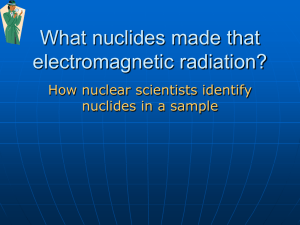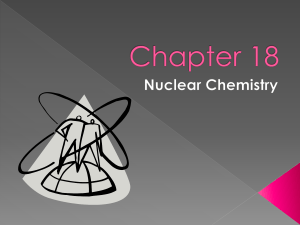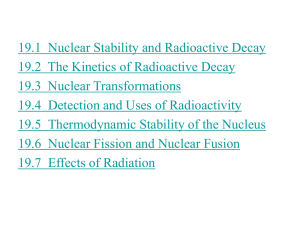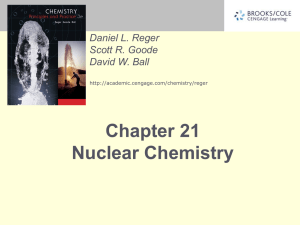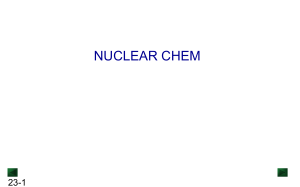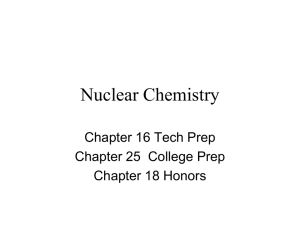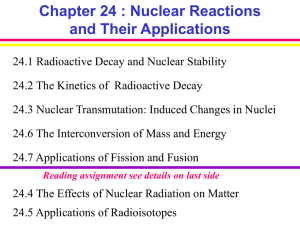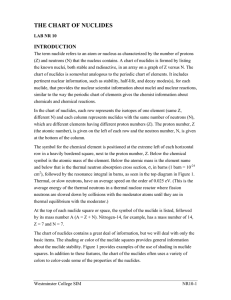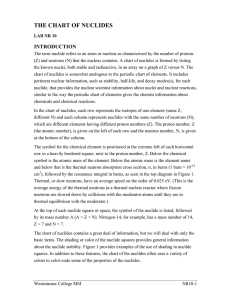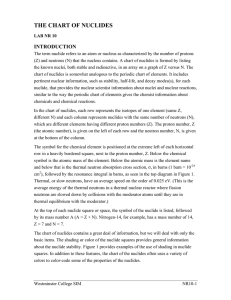INTERNATIONAL CHART OF THE NUCLIDES – 2001
advertisement
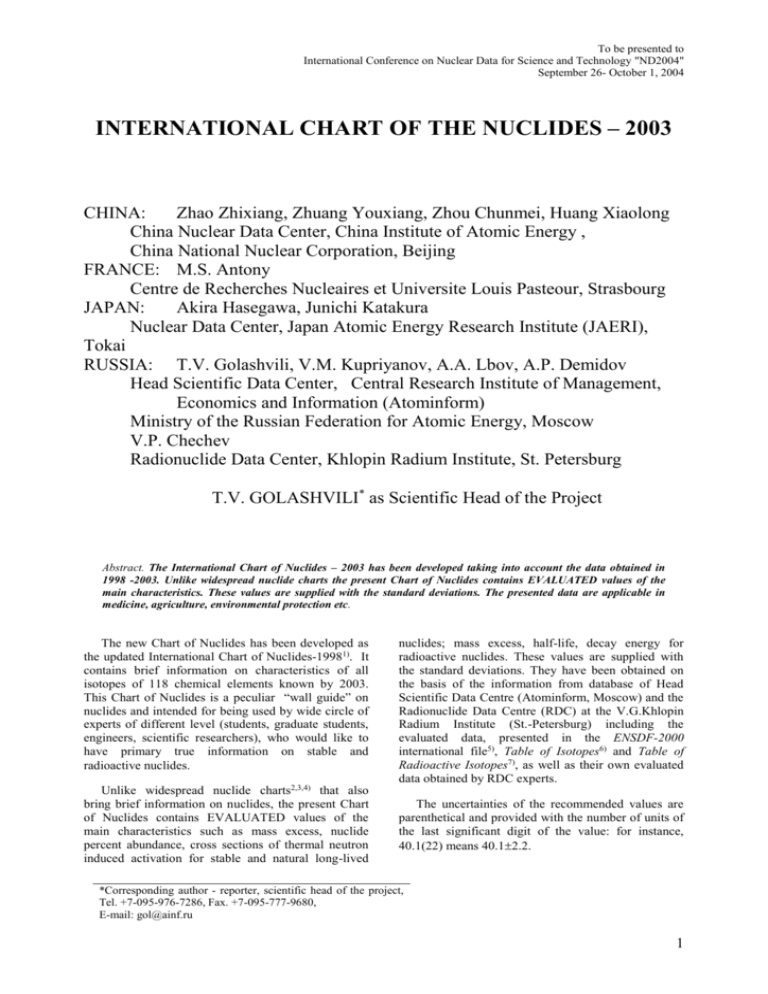
To be presented to International Conference on Nuclear Data for Science and Technology "ND2004" September 26- October 1, 2004 INTERNATIONAL CHART OF THE NUCLIDES – 2003 CHINA: Zhao Zhixiang, Zhuang Youxiang, Zhou Chunmei, Huang Xiaolong China Nuclear Data Center, China Institute of Atomic Energy , China National Nuclear Corporation, Beijing FRANCE: M.S. Antony Centre de Recherches Nucleaires et Universite Louis Pasteour, Strasbourg JAPAN: Akira Hasegawa, Junichi Katakura Nuclear Data Center, Japan Atomic Energy Research Institute (JAERI), Tokai RUSSIA: T.V. Golashvili, V.M. Kupriyanov, A.A. Lbov, A.P. Demidov Head Scientific Data Center, Central Research Institute of Management, Economics and Information (Atominform) Ministry of the Russian Federation for Atomic Energy, Moscow V.P. Chechev Radionuclide Data Center, Khlopin Radium Institute, St. Petersburg T.V. GOLASHVILI* as Scientific Head of the Project Abstract. The International Chart of Nuclides – 2003 has been developed taking into account the data obtained in 1998 -2003. Unlike widespread nuclide charts the present Chart of Nuclides contains EVALUATED values of the main characteristics. These values are supplied with the standard deviations. The presented data are applicable in medicine, agriculture, environmental protection etc. The new Chart of Nuclides has been developed as the updated International Chart of Nuclides-19981). It contains brief information on characteristics of all isotopes of 118 chemical elements known by 2003. This Chart of Nuclides is a peculiar “wall guide” on nuclides and intended for being used by wide circle of experts of different level (students, graduate students, engineers, scientific researchers), who would like to have primary true information on stable and radioactive nuclides. Unlike widespread nuclide charts2,3,4) that also bring brief information on nuclides, the present Chart of Nuclides contains EVALUATED values of the main characteristics such as mass excess, nuclide percent abundance, cross sections of thermal neutron induced activation for stable and natural long-lived nuclides; mass excess, half-life, decay energy for radioactive nuclides. These values are supplied with the standard deviations. They have been obtained on the basis of the information from database of Head Scientific Data Centre (Atominform, Moscow) and the Radionuclide Data Centre (RDC) at the V.G.Khlopin Radium Institute (St.-Petersburg) including the evaluated data, presented in the ENSDF-2000 international file5), Table of Isotopes6) and Table of Radioactive Isotopes7), as well as their own evaluated data obtained by RDC experts. The uncertainties of the recommended values are parenthetical and provided with the number of units of the last significant digit of the value: for instance, 40.1(22) means 40.12.2. *Corresponding author - reporter, scientific head of the project, Tel. +7-095-976-7286, Fax. +7-095-777-9680, E-mail: gol@ainf.ru 1 To be presented to International Conference on Nuclear Data for Science and Technology "ND2004" September 26- October 1, 2004 Nuclide mass excesses, , are expressed in MeV with (12C)=0 and corresponded to data of reference8). Half-life evaluated values (with uncertainties) are presented for radioactive nuclides. Nuclide percentage in natural mixture of isotopes for a given chemical element is mentioned for stable nuclides instead of half-life. Both values, i.e. half-life and abundance of isotopes in natural mixture, are presented for natural long-lived radioactive nuclides. Basic decay types with percentage of branching, and evaluated values (with uncertainties) of decay energies (Q-values, in keV) obtained on the basis of data5,8) are presented. Basic types of radiation (particles and photons) and mean values of radiation energy per decay (keV/decay) obtained on the basis of data7) and RDC evaluations are presented. Mean radiation energy per decay <R> is a quantitative characteristic indicating the contribution of the given radiation type to the energy (Q) released in the decay. Radiation capture cross sections (in barns) induced by thermal neutrons (activation cross section) are presented for the stable and natural long lived nuclides in accordance with reference10). Also the energies of the most intensive gamma-rays (in keV) are presented. Nuclides in the chart are arranged as Z-N diagram, where Z is the number of protons in a nucleus, N is the number of neutrons. Z grows on along the vertical from bottom to top; N grows on along the horizontal from left to right. The following information for each radioactive nuclide is contained in the information boxes arranged along the lines: 1. Nuclide symbol with mass number; 2. Mass excess; 3. Spin of ground state of nucleus; 4. Half-life; 5. Decay modes; 6. Decay energy; 7. Average radiation energies; 8. Energies of the most intensive radiation components; 9. Thermal neutron activation cross section. All the values in the first five lines are arranged in such a way that information on the same characteristic for different nuclides is put along the same horizontal line. Co 57 -59.3400(14) 7/2271.80 (5) d Q+ 836.0(4) 122 136 14 Figure 1. Information box for 57Co. Eu-155 -71.828(3) 5/2+ 4.753(14) a Q- 252.2(11) <> 47 86 105 Am-241 52.9294(20) 5/2 432.6(6) a SF Q() 5637.81(12) 5486 5443 5388 60 26 33 Figure 2. Information boxes for 155Eu and 241Am. As for the stable nuclides, the abundance of nuclide in natural mixture of isotopes (percentage) is indicated in the forth line and the thermal neutron activation cross section is indicated in the last line. Figure 3 below presents the examples of the stable and natural unstable nuclide information boxes for 59Co and 40K. Co 59 -62.2239(14) 7/2 100% 17.18(6) K-40 -33.5350(3) 4 0.0117(1)% 1.258(10)E9 a ,+ Q- 1311.1(1) <>455 Q+1504.9(3) 1461 30(8) Figure 3. Information boxes for 59Co and 40K. As to history, the necessity to develop the international charts of nuclides was discussed in 1994 at International Conference on Nuclear Data for Science and Technology, Gatlinburg, the USA. IAEA international working group had confirmed that there is a necessity to develop the international charts of nuclides. Opinion of more than 200 respondents from national and international organizations as a result of 1994 – 1996 attitude survey was the reason for developing the international charts of nuclides. Figures 1 and 2 below present the examples of the information boxes for 57Co, 155Eu and 241Am. 2 To be presented to International Conference on Nuclear Data for Science and Technology "ND2004" September 26- October 1, 2004 REFERENCES Zhao Zhixiang, Zhuang Youxiag, Zhou Chunmei, Huang Xiaolong (China), M.S.Antony 1) (France); Akira Hasegawa, Junichi Katakura, (Japan); V.P.Chechev, T.V.Golashvili, A.A.Lbov (Russia). International Chart of Nuclides-1998. Scientific Head of the Project: T.V.Golashvili. Atominform, Moscow, 1998. 5) Evaluated Nuclear Structure Data File–2000 and NUDAT, National Nuclear Data Center, Brookhaven National Laboratory, USA. 6) R.B.Firestone. (Ed.) C.M. Baglin, (CD-Rom Ed.) S.Y. Frank Chu, Table of Isotopes, Eighth Edition, 1998 Update, John Wiley and Sons, New York (1998). 7) E Browne, R.B. Firestone, (Ed.) V.S. Shirley, Table of Radioactive Isotopes, John Wiley and Sons, New York (1986). 8) G. Audi, A.H. Wapstra, Nucl.Phys. A595 (1995) 409. Chart of the Nuclides, Knolls Atomic Power Laboratory, Fifteenth Edition, U.S. Department of Energy, 1996. 9) T.V. Golashvili, V.P. Chechev, A.A. Lbov, Nuclide Guide, Moscow, 1995, Atomniform. P. Raghavan, At. Data Nucl. Data Tables 42 (1989) 189. 3) Chart of the Nuclides, Nuclear Data Center of JAERI, 2000. 10) T.S. Bulanova, A.V. Ignatyuk, A.B. Pashchenko, V.I. Plyaskin. Radiation capture of neutrons. Handbook. M.: Ehnergoatomizdat, Moscow, 1986. 2) 4) M.S Antony, Chart of the Nuclides – Strasbourg 1992: Centre de Recherches Nucleaires et Universite Louis Pasteur, Strasbourg, 1993. 3

